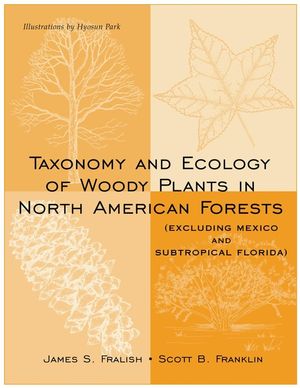Taxonomy and Ecology of Woody Plants in North American Forests : (Excluding Mexico and Subtropical Florida)ISBN: 978-0-471-16158-5
Hardcover
624 pages
February 2002
 This is a Print-on-Demand title. It will be printed specifically to fill your order. Please allow an additional 15-20 days delivery time. The book is not returnable.
|
||||||
Preface.
1. Introduction to Taxonomy.
2. Introduction to Forest Ecology.
Part I: Taxonomic Concepts and Methodology.
3. Plant Classification.
4. Nomenclature.
5. Collecting and Preserving Specimens.
6. Key Construction and Use.
Part II: Gymnosperms (Division Pinophyta).
7. The Gymnosperms: An Overview.
8. Gymnosperm Vegetative and Reproductive Structures.
9. Order: Pinales I: Pinaceae: Pinus.
10. Order: Pinales II: Pinaceae: Larix, Picea, Abies, Tsuga, Pseudotsuga.
11. Order: Pinales III: Cupressaceae.
12. Order: Taxales, Ginkgoales, and Cycadales.
Part III Woody Angiosperms (Division Magnoliophyta)13. The Woody Angiosperms: An Overview.
14. The Woody Angiosperm Leaf.
15. The Woody Angiosperm Twig.
16. Angiosperm Flower and Fruit Structures.
17. Class: Magnoliopsida;
Subclass: Magnoliidae. Magnoliaceae, Annonaceae, Lauraceae, Calycanthaceae, Aristolochiaceae,Illiciaceae, Schisandraceae, Ranunculaceae, Berberidaceae, Menispermaceae.
18. Class: Magnoliopsida;
Subclass: Hamamelidae I. Platanaceae, Hamamelidaceae, Ulmaceae, Moraceae, Juglandaceae,Myricaceae, Casuarinaceae.
19. Class: Magnoliopsida;
Subclass: Hamamelidae II. Fagaceae, Betulaceae.
20. Class: Magnoliopsida;
Subclass: Dilleniidae. Tiliaceae, Salicaceae, Ericaceae, Clethraceae, Cyrillaceae, Sapotaceae,Ebenaceae, Styracaceae, Symplocaceae, Clusiaceae.
21. Class: Magnoliopsida;
Subclass: Rosidae IRosaceae, Fabaceae, Elaeagnaceae, Thymelaeaceae, Hydrangeaceae,Grossulariaceae, Iteaceae, Cornaceae, Garryaceae, Nyssaceae,Aquifoliaceae, Celastraceae, Rhamnaceae, Vitaceae, Araliaceae.
22. Class: Magnoliopsida;
Subclass Rosidae IIAceraceae, Sapindaceae, Anacardiaceae, Hippocastanaceae,Staphyleaceae, Rutaceae, Simaroubaceae.
23. Class: Magnoliopsida;
Subclass: AsteridaeOleaceae, Bignoniaceae, Scrophulariaceae, Rubiaceae,Caprifoliaceae, Adoxaceae.
24. Class: Liliopsida (Monocotyledoneae)Arecaceae, Poaceae, SmilacaceaePart IV: Forest Community Ecology: Combining Species into Communities.
25. Introduction to Forest Ecology and Classification.
26. Forest Environment and Cover Types Regions 1 and 2: Northern Conifer-Hardwoodand Northern Hardwood-Conifer Forests.
27. Forest Environment and Cover Types Region 3: Central Hardwood Forest.
28. Forest Environment and Cover Types Region 4: Southern Pine-Hardwood Forest.
29. Forest Environment and Cover Types Regions 5 and 6: Rocky Mountain Conifer Forests.
30. Forest Environment and Cover Types Region 7: Northern and Southern Coastal Conifer Forests.
Glossary of Technical Terms.
Glossary of Genus and Species Names.
References.
Index of Species.
Subject Index.
1. Introduction to Taxonomy.
2. Introduction to Forest Ecology.
Part I: Taxonomic Concepts and Methodology.
3. Plant Classification.
4. Nomenclature.
5. Collecting and Preserving Specimens.
6. Key Construction and Use.
Part II: Gymnosperms (Division Pinophyta).
7. The Gymnosperms: An Overview.
8. Gymnosperm Vegetative and Reproductive Structures.
9. Order: Pinales I: Pinaceae: Pinus.
10. Order: Pinales II: Pinaceae: Larix, Picea, Abies, Tsuga, Pseudotsuga.
11. Order: Pinales III: Cupressaceae.
12. Order: Taxales, Ginkgoales, and Cycadales.
Part III Woody Angiosperms (Division Magnoliophyta)13. The Woody Angiosperms: An Overview.
14. The Woody Angiosperm Leaf.
15. The Woody Angiosperm Twig.
16. Angiosperm Flower and Fruit Structures.
17. Class: Magnoliopsida;
Subclass: Magnoliidae. Magnoliaceae, Annonaceae, Lauraceae, Calycanthaceae, Aristolochiaceae,Illiciaceae, Schisandraceae, Ranunculaceae, Berberidaceae, Menispermaceae.
18. Class: Magnoliopsida;
Subclass: Hamamelidae I. Platanaceae, Hamamelidaceae, Ulmaceae, Moraceae, Juglandaceae,Myricaceae, Casuarinaceae.
19. Class: Magnoliopsida;
Subclass: Hamamelidae II. Fagaceae, Betulaceae.
20. Class: Magnoliopsida;
Subclass: Dilleniidae. Tiliaceae, Salicaceae, Ericaceae, Clethraceae, Cyrillaceae, Sapotaceae,Ebenaceae, Styracaceae, Symplocaceae, Clusiaceae.
21. Class: Magnoliopsida;
Subclass: Rosidae IRosaceae, Fabaceae, Elaeagnaceae, Thymelaeaceae, Hydrangeaceae,Grossulariaceae, Iteaceae, Cornaceae, Garryaceae, Nyssaceae,Aquifoliaceae, Celastraceae, Rhamnaceae, Vitaceae, Araliaceae.
22. Class: Magnoliopsida;
Subclass Rosidae IIAceraceae, Sapindaceae, Anacardiaceae, Hippocastanaceae,Staphyleaceae, Rutaceae, Simaroubaceae.
23. Class: Magnoliopsida;
Subclass: AsteridaeOleaceae, Bignoniaceae, Scrophulariaceae, Rubiaceae,Caprifoliaceae, Adoxaceae.
24. Class: Liliopsida (Monocotyledoneae)Arecaceae, Poaceae, SmilacaceaePart IV: Forest Community Ecology: Combining Species into Communities.
25. Introduction to Forest Ecology and Classification.
26. Forest Environment and Cover Types Regions 1 and 2: Northern Conifer-Hardwoodand Northern Hardwood-Conifer Forests.
27. Forest Environment and Cover Types Region 3: Central Hardwood Forest.
28. Forest Environment and Cover Types Region 4: Southern Pine-Hardwood Forest.
29. Forest Environment and Cover Types Regions 5 and 6: Rocky Mountain Conifer Forests.
30. Forest Environment and Cover Types Region 7: Northern and Southern Coastal Conifer Forests.
Glossary of Technical Terms.
Glossary of Genus and Species Names.
References.
Index of Species.
Subject Index.



